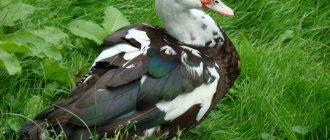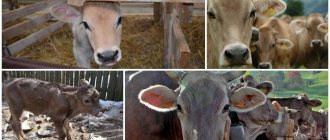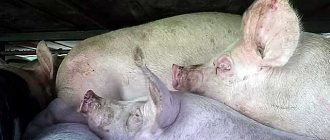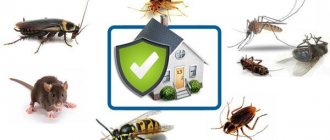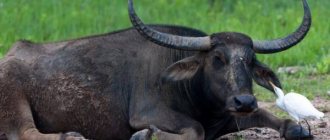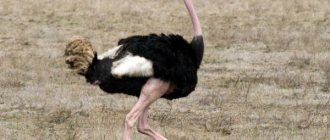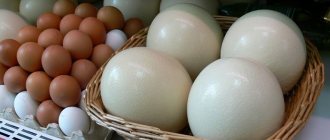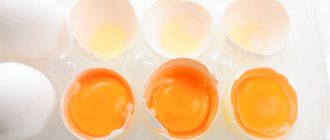Livestock » Sheep
0
5806
Article rating
Kira Stoletova
Depending on the purpose and direction of the breed, the indicator of how much a ram weighs ranges from 25 to 180 kg. The weight of the animal is also influenced by the sex of the animal: males significantly exceed females in weight.
Ram
How much does it weigh depending on the breed?
Woolen
Animals are bred for wool and sheepskins. There are coarse-wool (Romanov variety), semi-fine-fleece and fine-fleece (the length of the hairs on the fleece reaches 30 cm) directions.
The live weight of rams of these species is usually small. For example, the famous Romanovka weighs only 45-50 kg. But there are large breeds: Caucasian, Lincoln (the weight of an adult male is more than 150 kg). Animals are distinguished by their unpretentiousness and good fertility.
Fine-fleece
These sheep are used to produce high quality wool, and up to 12 kg of raw material can be sheared from one individual. The main breeds of the direction: Altai; Stavropol; merino; Caucasian
The average weight of a fine-wool lamb is 70-80 kg.
Semi-fine fleece
The direction is also called meat and wool. Animals gain live weight at a good rate, while their wool is also of high quality and can be used to produce warm and beautiful products.
There are many breeds: Romney March; Kuibyshevskaya; Tien Shan; North Caucasian. The average weight of a sheep is 90-100 kg, and the meat has good taste characteristics.
Sheep are significantly inferior, their weight is 50-58 kg.
Meat
Texel
Sheep are bred for meat. Animals grow quickly and are able to reach slaughter weight in 5-7 months using pasture.
Varieties common in our country: Kuibyshevskaya (male weight is about a hundredweight), Gorky (up to 130 kg), Dorper (early ripening breed weighing 140 kg), Texel (up to 130 kg).
Meat-fat, or fat tail
These animals are popular in Central Asia; they feel uncomfortable in cold and damp climates. Representatives of the breed are characterized by the deposition of fat in the fat tail, a kind of “bag” located under the tail.
Sometimes the fat tail's weight reaches 25 kg. Fat tail lard has an exquisite taste. Types: Edelbaevskaya (ram weight up to 160 kg), Gissar (up to 190 kg), Kalmyk (weight 120-130 kg).
Dairy varieties of sheep, whose milk is used to make cheese, are rare in our country. A prominent representative of dairy sheep is the East Friesian breed.
Animals are capable of producing up to 700 liters of fatty (over 6%) milk per season, and the live weight of rams reaches 100 kg.
It should be noted that wool can also be cut from meat animals, and sheep of woolly breeds can be used for meat.
Dwarf
The representative of the direction is the Wessent breed, the average weight does not exceed 20 kg. These kids eat almost any food, have a peaceful disposition, and for their amazing ability to bring lawns into perfect order, they have received the nickname “ecological lawnmowers.”
Meat yield at slaughter
The body weight of rams of different productivity groups can thus be quite large. The net weight of meat at the exit after slaughter for these animals, of course, is less than the weight of the carcass.
Before slaughter, sheep are first weighed and then sent to special pens, where they are left without food and water for 24 hours. During the period of fasting, the animals empty their bladder and intestines. As a result, their weight is reduced by 2.5-3.5%.
After slaughter, the sheep are skinned, the head and hooves are removed, and gutted. The slaughter yield by weight for rams can be 35-60%. At the same time, the meat itself accounts for 64-70% of the net weight of the carcass, kidneys - 1.4-1.6%, bones - 25-30%, tendons and cartilage - 1.6-2.4%. Losses during storage and cutting may be 1.1%.
Thus, the advantages of sheep, among other things, include a fairly large yield of meat. The average weight of a ram, as we found out, is 100-110 kg. Consequently, 35-50 kg of meat can be obtained from each such animal.
Polled sheep are rarely bred on farms. In most cases, the males of these animals have large horns. The average weight of a sheep after cutting is 50 kg. The weight of the horns of these animals often reaches as much as 20 kg. That is, only 2 times less.
In just one day, an adult sheep can eat up to 10 kg of feed. Farmers try to choose pastures with the most luscious grass for such animals. In order for sheep to gain weight faster, they must be given additional silage, crushed grain, bran, and root vegetables.
Sheep are slaughtered, as already mentioned, usually under the age of one year. The meat of two-year-old sheep is also quite edible. But rams at the age of 3 years are considered, unfortunately, unsuitable for slaughter. By this time, their meat becomes tasteless and very tough.
Factors influencing live weight
The following factors influence a lamb’s net weight and the rate at which it gains:
- Direction and breed. Only meat rams are distinguished by their large size and produce a high meat yield, while dwarf breeds weigh only about 20 kilograms, which is the average ram weight for such individuals.
- Gender of the animal. In all breeds, the average weight of a male significantly exceeds the weight of a sheep.
- Age. Maximum condition is achieved at the age of 3-4 years. On average, a 4-month-old lamb does not weigh more than 35 kg, even if it is ready for slaughter.
- Feeding and care also affect the live weight of a domestic sheep. Sheep nutrition is usually not a problem for farmers, but feed and vitamins are necessary for good sheep condition.
Dwarf sheep species
Animals in this category are distinguished by their miniature dimensions. The body length of males does not exceed 60 cm in length. Females can reach 40 cm. As for lamb weight, its value does not exceed 25 kg.
Dwarf varieties of sheep are distinguished by their endurance and unpretentiousness. Sheep eat pasture, young branches and tender bark of trees. The disadvantages of the representatives are their minimum meat production ratio.
Lamb weight after cutting
The above values apply to live animals.
After slaughter, minus the weight of the skin, head, legs and entrails, the carcass loses more than half its weight. The average meat yield per sheep is 48%.
The slaughter yield of lamb varies among different breeds; it is higher among meat varieties. For example, when slaughtering a Romanov lamb with a live weight of 42 kg, a carcass of 14 kg is obtained.
The slaughter yield was 45%. For a Gissar sheep, an individual weighing 50 kg will produce a carcass of 27 kg, with a slaughter yield of 54%.
Slaughter weight of sheep and rams
The concept of slaughter weight includes the mass of meat on the bones and fat deposits, both internal and fat tail. Weight is determined by pre-slaughter weighing of the sheep and subsequent weighing of the meat.
Sometimes the weight of an animal is determined using measurements with a special tape or using a table. But in this case the error may be several kg.
The slaughter yield within the same breed of sheep can vary depending on the sex, age and fatness of the animal.
Thus, breeding animals culled by age are inferior in quantity of meat and carcass quality to young, fattened animals.
An important indicator of the quality of a carcass is the ratio of the amount of pulp and bones. In other words, how much of the skeleton is covered with meat. For young animals this ratio is the most favorable.
Advice! You can distinguish young lamb from the meat of an old animal by the color of the fat. Young lard is white, while old lard has a yellowish tint.
The weight of females is significantly lower than that of rams - up to 40%. For example, an adult lamb of the Kuibyshev variety weighs 100 kg, and a sheep only 60 kg. Based on this, they prefer to select males for meat fattening. The eggs go to repair the herd.
Sheep fat deposits (lamb fat)
Fat on a sheep carcass can be:
- internal - it is deposited on the kidneys, stomach, intestines (it is also called the “omentum”);
- subcutaneous - it forms a “watering” of the entire surface of the meat under the skin layer;
- intermuscular - it is deposited in the layers between individual muscle groups.
The total amount of fat is distributed throughout the carcass depending on the specialization of the breed. In wool animals, it is deposited on the internal organs.
In meat, fat is evenly distributed between the muscles, giving the meat juiciness and tenderness when cooked.
Experts consider the ideal fat content in a lamb carcass to be about 25%, of which half is subcutaneous fat and at least 9% intermuscular.
Yield of sheep by-products
Offal refers to the edible parts of the sheep's innards and head. These are: heart, liver, kidneys, tongue, brains - category 1; scar, spleen, lungs, trachea – category 2. The overall carcass yield of this product is about 9%.
Weighing methods
Breeding rams (sheep) involves individual assessment of their productive and breeding characteristics on a regular basis. As part of the assessment manipulations, the animal’s compliance with a set of established traits is monitored, which includes monitoring weight gain.
Control of the weight parameters of a ram is one of the main points that make up the list of rules for their breeding. Tracking growth progress is necessary to determine the cost-effectiveness of maintenance. Analysis of the weight gain graph allows you to find out the ratio of costs associated with feeding, ensuring proper living conditions and material profit, which includes covering the corresponding costs.
To determine the weight of a ram, certain equipment or a special calculation formula can be used to find the approximate value of this indicator. The second option is among the most preferred for mid-level farmers. This is due to the absence of the need to purchase expensive weighing equipment, incur costs associated with its installation and configuration, and other related factors.
The main measurement parameter is the size of the animal's chest circumference. Measurements are taken behind the front legs and shoulder blades. The tension of the measuring tape is of great importance, since hair can interfere with the accuracy of the measurement.
The obtained value is used as one of the variables in the formula for calculating the live weight of the ram. There are many such formulas, which increases the spread of calculation accuracy and reduces the efficiency of measurement manipulations. Given this, most farmers use a special measuring tape. It contains metric parameters and weight values corresponding to these parameters. The numbers indicating the mass of the animal can be supplemented with several values corresponding to the weight characteristics of different breeds of sheep. The belonging of a particular numerical name to a suitable numerical column is indicated by the corresponding color.
What affects weight?
In addition to whether a sheep belongs to a certain breed, the rate of weight gain and its amount are influenced by the gender of the animal, its age, feeding and housing conditions.
It is customary to keep sheep on pasture for most of the year. On rich grass stands, animals develop quickly. If camps are organized with the possibility of feeding with grain, then the highest quality carcasses are obtained from the sheep.
During the stall period, sheep are driven into sheds - covered pens protected from the wind.
The animals' diet includes meadow or bean hay, concentrates (barley, oats), and salt is required in the feeders. Nursing queens are fed vegetables - carrots, beets, pumpkin.
Contraindications and harm
The use of lamb fat is contraindicated in the following cases:
- tendency to be overweight, overweight, obesity;
- high blood cholesterol, atherosclerosis, heart and vascular diseases;
- gastritis;
- stomach and intestinal ulcers;
- colitis;
- liver diseases accompanied by stagnation of bile;
- skin prone to allergies.
Lamb fat should be used with caution during breastfeeding. Indigestion and colic in infants are explained by the negative influence of the product. Fat can be added to baby food from nine months
If a child develops diarrhea, nausea, or apathy, it should be removed from the diet. Also, you should not apply compresses to infants - sensitive skin may cause irritation and allergies.
Fat can be introduced into baby food from nine months. If a child develops diarrhea, nausea, or apathy, it should be removed from the diet. Also, you should not apply compresses to infants - irritation and allergies may occur on sensitive skin.
At what speed do they pick up?
Young animals have the highest rates of live weight gain. Depending on the grass stand on the pasture, fertilizing and species affiliation, the daily gain is 300-500 grams.
The limit of 600 g is exceeded every day by the champions in the fastest growth - texels and dorpers: these animals can be called “broilers” of the mutton family.
Product quality
Meat is tissue of muscle, fat, connective and bone nature. A small presence of lymph nodes, vessels, and cartilage is acceptable in meat. The muscle tissue of the animal makes up 50-75% of the total meat. It also depends on the fatness of the animal and its membership in the natural group.
Meat is nutritious with proteins (up to 22%), fats (up to 2-3%), inorganic substances (vitamins, carbohydrates, amino acids and other compounds - up to 5%).
Adipose tissue, or refractory lipid, obtained from aged animals is absorbed very poorly. The best digestibility of this product occurs when consuming young meat or the meat of a castrated animal.
Fresh meat has a unique texture, smell and taste, so it may not be to everyone’s taste.
3 hours after slaughter, the rigor rigor stage begins. It is characterized by the fact that excess moisture comes out of the meat. The smell and taste of this meat are no longer too pronounced, it is tender and juicy.
Average weight of a yearling ram
By the age of one year, the growth of the animal stops, the ram reaches the mass of an adult individual of its species. On average, a meat ram at the age of 12 months weighs 90-100 kg.
If the animal is intended to be fattened for meat, it is not advisable to keep it further. As a rule, younger individuals are slaughtered - at the age of 7-10 months. Lambs of early maturing breeds can be slaughtered at the age of 4 months, obtaining the most tender lamb.
The most convenient for use is considered to be a carcass of 18-20 kg.
North Caucasian, 60-120 kg
This is a meat-haired breed that was bred in 1944-1960. Sheep of the North Caucasian breed are distinguished by their large growth. They are white in color, but there may be small spots on the ears, legs and nose of a darker color.
The ewes of this breed weigh from 55 to 58 kg, while the weight of rams is from 90 to 100 kg, with a maximum weight of 150 kg. Most often this breed can be found in the North Caucasus, Armenia and Ukraine. Another advantage is its high fertility. 100 queens can produce about 140 lambs.
How to achieve rapid weight gain?
Only healthy and young animals are selected for fattening. Castrating lambs at the age of 4 months will avoid unnecessary fights in the flock.
Castrati have meat that is more tender than that of uncastrated rams, but they also become fat faster.
After weaning the lambs from their mothers, they are transferred to a pasture rich in forbs.
Additionally, salt lick with added minerals is provided for grazing. Feeding sheep with crushed grain in an amount of 200-300 g per head will significantly accelerate weight gain.
Argali, 65-180 mm
This mountain sheep lives in Central and Central Asia, and is now in the Red Book. Argali is considered the largest wild sheep, which can weigh from 65 to 180 kg. There are several subspecies, but the largest is the Pamir argali. Argali can be of different colors, from sandy light to grayish-brown. Dark stripes are visible on the sides. They live in open spaces.
How to measure?
Let's look at several ways to find out the weight of a sheep.
Check weighing
The exact weight of the sheep must be known before vaccination. For this purpose, platform scales installed in a special pen are most often used.
It is important to remember these rules: Acceptable accuracy: for adults - up to 1 kg, for lambs - up to 0.5 kg.
Weight is determined in the morning, before the first feeding of the animals. The results are recorded. This method is considered the most accurate.
Calculation based on measurements (without scales)
Sometimes there are situations when you have to determine the body weight of a sheep or lamb in the field, without equipment.
In this case, the method of calculation by measurements will come to the rescue, allowing you to determine the weight not as accurately as scales, but still acceptable, with an error of no more than 5-10%. And this is enough to cull animals and determine the effectiveness of feeding.
It goes like this:
- Measure the circumference of your chest behind your shoulder blades (A).
- Measure the length from withers to tail (B). Each result obtained is measured in centimeters.
- Next, use the formula: AxBx2.5/100.
The resulting result is the live mass.
Feeding scheme
The weight of calves by month corresponds to the norms if the feed contains all the necessary nutrients. In order for animals to grow faster, the farmer needs to know the feeding habits.
First month
At the first stage of animal development, the owner’s main task is to strengthen the calf’s immunity. Only dairy products are used for this. Within an hour after birth, he should receive valuable colostrum. It is distinguished from milk by its high protein content, which helps strengthen the body of babies.
Mother's colostrum is the main diet for the calf immediately after calving.
A newborn bull is fed 5-6 times a day. They do this using bottles with nipples. The hole in them must correspond to the age of the animals in order for the sucking reflex to develop correctly. Each individual is provided with a separate nipple. After use it is disinfected. By the age of one month, the number of feedings is reduced to 3-4 times.
Fresh milk is given, but frozen milk is also suitable. Its temperature should be 37-38 °C. Milk from different cows is often mixed. This provides the calf with antibodies that will help build immunity. To ensure that the bull gains weight well and does not carry weight, vitamins are also added to the food - biovit or others.
Second month
Gradually switch to solid food. They start with starter feed. It consists of products containing elements necessary for a growing organism. Such food is easily digestible because it contains the following products:
After the first week of feeding with compound feed, ruminal digestion is established, so hay is introduced into the diet. Every day, portions are increased by 150-200 g. Silage and haylage are added to the main feed.
After 60 days, the calves are given root vegetables and yogurt. Oatmeal jelly will provide them with vitamins A, D, E. Feeding is done often, in small portions. The approximate amount of feed per day is 1.5-1.6 kg, including 1 kg of hay.
Third month
The bull's body is completely ready for the transition to solid food. It is worth providing it with plenty of protein. Milk is gradually being replaced with products that have high energy value. Soy-based concentrates are good for this. It is given in a dose of 2% as part of compound feed, which also contains the following:
- peas – 30%;
- barley – 23%;
- corn – 20%;
- minerals and premix – 5%.
For optimal development, the calf needs a sufficient amount of succulent hay, so from the end of 3 months the baby is taught to independently graze on pastures
You can prepare the food yourself, you just need to calculate the proportions correctly. This composition contributes to the rapid weight gain of bulls. At this age they are not selective in food, weigh about 100 kg, eat a lot and always leave their feeders empty. They are also given bran, fruits, and vegetables.
From 4 months to six months
During this period, for good weight gain, it is worth giving animals 1-2 kg of feed per day. In the warm season they are grazed for 2-3 hours
It is important that there is water and a shaded place nearby. In cold weather, calves also need to be walked
They are briefly released into the pen, which has a canopy. When grass is introduced into food, it is first dried. Then they gradually switch to fresh ones. This will help prevent stomach upset. By six months, milk is completely removed from the diet.
Read also: Interesting facts about rabbits
From 6 months to a year
For a bull, this is a period of intensive growth and muscle mass building. The musculoskeletal system is actively developing. Feeding is carried out 3 times a day. The diet should contain mixed feed, hay, and concentrates.
From 8 to 12 months the feeding principle remains the same. In order for a bull to gain weight, it is worth increasing the amount of vitamins and nutrients. As the animal grows, the need for them also increases. If you do not provide it with the necessary elements, this will have a bad effect on the body of the bull, which will entail the following consequences:
- inactivity of the animal;
- stopping weight gain;
- weight loss;
- deterioration of immunity.
Records
In the world of sheep, there are several unique breeds and animals that have become real weight record holders.
The heaviest and lightest breeds
Tajik breed of sheep "Joydori".
Tiny sheep, weighing no more than 6 kg, were obtained as a result of breeding work with representatives of the Southdown breed.
Representatives of the meat and fat breed are considered heavy sheep: Gissar sheep reach 85 kg, rams – 160-170 kg; The weight of a fat tail is on average 30 kg, but there are known cases of a 50 kilogram fat bag.
The Tajik and Edilbaev breeds are not far behind: rams weigh about 120 kg, sheep - up to 70 kg.
Dairy direction
Sheep after giving birth to lambs produce from 1 to 3 liters of milk per day.
In terms of fat content, it is one and a half times higher than goat's and three times higher than cow's. The fat content is 5-7 percent, protein - 6 percent. Delicious cheeses (Roquefort, feta, pecorino, ricotta), yoghurt and feta cheese are made from sheep's milk. Of course, all sheep begin to lactate after lambing. However, there are animals with the highest milk yields. Scientists are working on developing productive breeds, and dairy sheep farming in some countries enjoys government support. Breeds of dairy sheep: German East Frisian, white Sardinian, Laconian, British dairy, Chios with black spots on the horned head and ears, Arabian Awassia with a brown head, Israeli Assaf with long ears, Dutch zwartbles. Females begin to be milked after lambing. Sheep usually give birth to lambs in the spring. They continue to lactate until autumn. When the lambs grow up, the milk disappears. The next lactation occurs after the next birth.
All dairy animals are united by the following common characteristics: per lactation, up to 300-600 liters of milk are obtained from one sheep, females are fertile, the weight of animals is, on average, 50-70 kilograms.
Advantages and disadvantages
milk 5-7% fat, suitable for making cheese; versatility (meat and milk); high fertility.
low slaughter meat yield (less than 40%); short lactation period (3-5 months).
